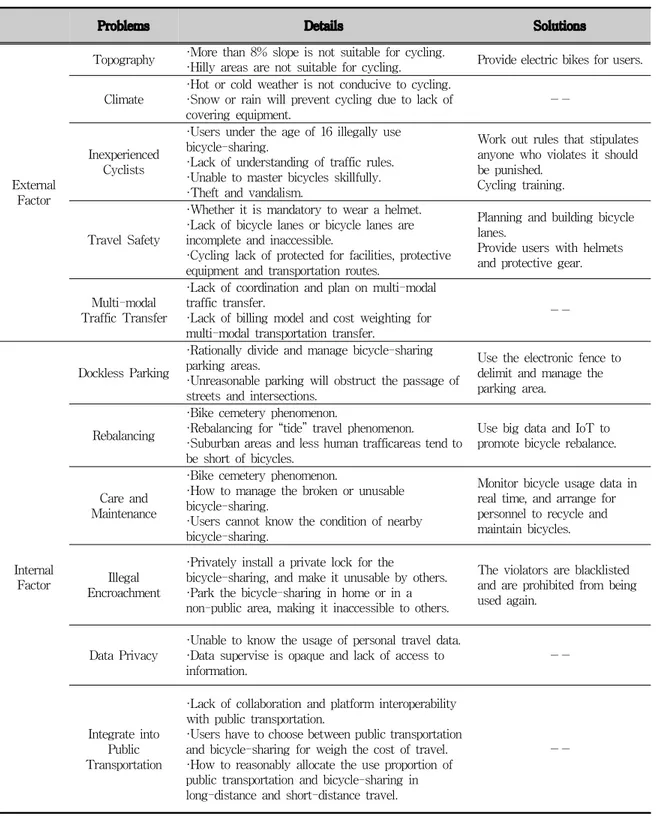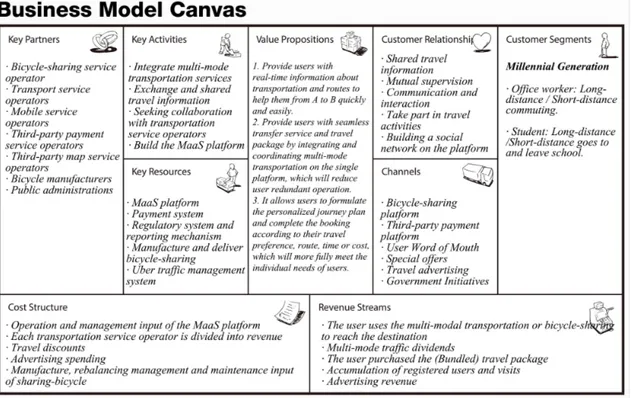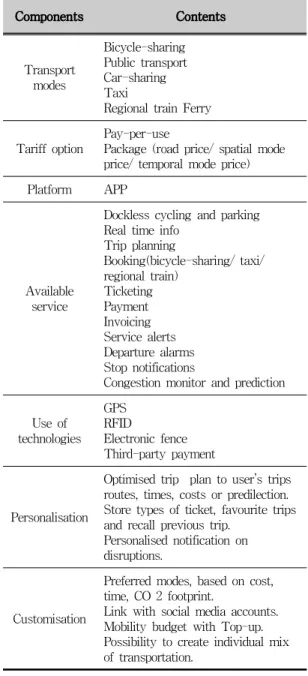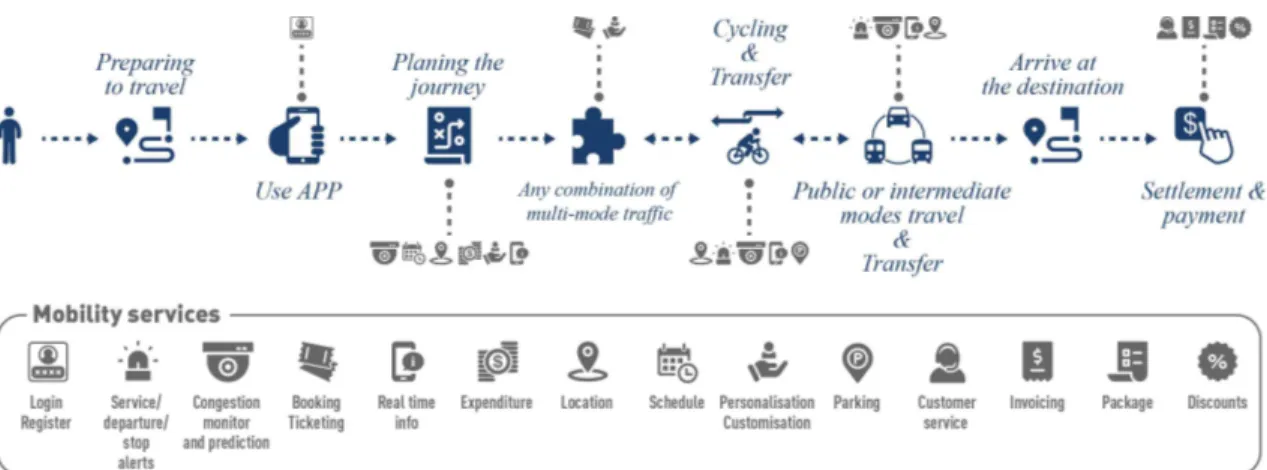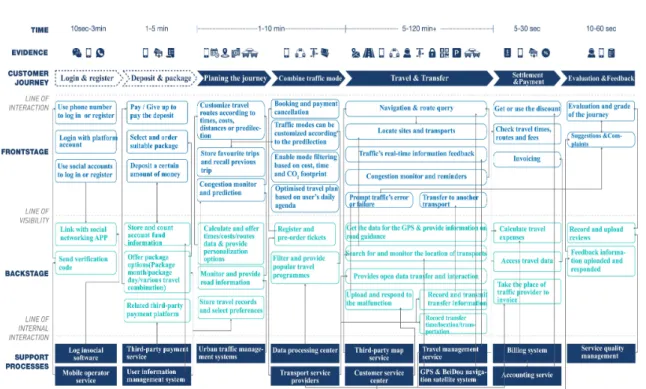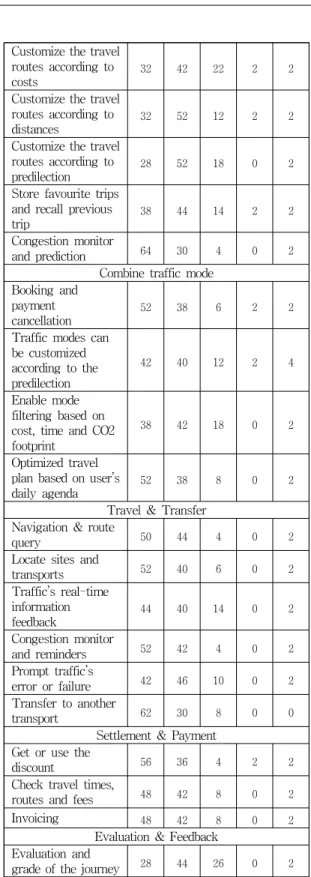Service Model Research of Bicycle-sharing based on Mobility-as-a-Service (MaaS)
전체 글
(2) 서비스연구, 제9권 제4호, 2019.12 1. Introduction. personalized. service. passengers.. After. for. different. considering. the. types. of. literature. sustainable. research, it can be easily found that MaaS is. development, the transportation industry has always. dominated by the public transport or government. been in a state of disorder in the past decades. On. departments and intermediate and private transport. the one hand, the urban administrators face. usually participates in MaaS as auxiliary system.. capacity bottlenecks of infrastructure and capital. According the data of WRI, intermediate transport. (König et al, 2016). With the change of people's. represented by bicycle-sharing, as a widely used. travel habits, the public transit agencies just. and sustainable travel mode, attracts more and. provide. for. more attention (EMBARQ, 2014). Especially the. citizens (Atkins Mobility, 2015), and they can't. traditional bicycle-sharing mode has changed from. increase transportation choice and frequency to. station-based to free-floating models and as a. satisfy people's need such as the higher frequency. result the number of bicycle-sharing has increased. of commuting and non-traditional destinations for. nearly 12 times in the past 6 years (Per million. travel plans. On the other hand, in the face of. people share 3988 bicycles) (Arthur, 2018). On the. increasingly serious problem of air pollution and. other hand, most scholars still focus on the theory. resource exhaustion, most areas of developed. research of MaaS, such as the explanation of. countries implement rigid policy to ensure the. framework, influence of society and advantages and. low-carbon travel, for example, the private vehicle. disadvantages of the model, consequently, the. travel is restricted and vehicles which use gasoline. research about how to apply the service model is. or diesel oil are is prohibited to produce (Arthur,. very little. In conclusion, the analysis of this. 2018).. the. research mainly focuses on the service framework. the. and travel modes. Based on the concept of MaaS, it. background above, Mobility as a Service (MaaS) is a. puts forward a new service model to make the. new. offers. travel modes become more various and flexible.. transformative mobile solutions to solve the problem. The service model is so convenient that many. "how to delivery and consumption of transport (or. people choose it instead of personal vehicles to. mobility)?" MaaS not only satisfies fast, reliable,. complete your daily commute. The purpose of this. convenient and personalized travel demand but also. research is to build a traditional community system,. it has a high degree of flexibility to adapt to travel. which. trends.. intelligent mobility, and let bicycle-sharing of. From the perspective of global. homogenized. As. personalized. a. result,. travel. concept. mobility. this. need. intelligent. opportunity. can't of. satisfy. people.. mobility.. In It. lets. human-centeredness. integrate. into. mobility service make new relationship with users. It is said that MaaS has opened up a whole new. and play a positive role in their society life.. global market worth trillions of dollars (Sochor et al, 2015). On the one hand, MaaS mainly focuses on the different design methods and provide. 20.
(3) Service Model Research of Bicycle-sharing based on Mobility-as-a-Service (MaaS). 2. Introduction to Mobility as a Service (MaaS). 2008). What's more, MaaS also includes hot points of current transportation field. They include the integration, sustainability, IoT, sharing economy, smart and seamless mobility, and interconnectivity. 2.1 Definition of MaaS. and. from A to B rather than the individual transport. Alliance, 2017). In recent year, it has attracted the. modes and services. It not only aims to bridge the. attention of western developed countries and made. gap between public and private transport operators. communication for the global transportation service.. on a city, intercity and national level, but also. MaaS as the new concept, it can be seen as. envisages re-packaging of included the currently. combined mobility services (CMS) and provides. fragmented tools and services a traveller needs to. subscription of travel service about multi-modal. conduct a trip, which can purchase one service or. transportation. It means that MaaS can offer a. combinations. tailored mobility package with different transport. one-stop-shop. the relationship between users, MaaS operators, transport operators and travel. The multiple travel. objectives of multi-modal system (CIVITAS, 2016).. services offer various travel modes through primary. MaaS as a type of multiple travel services bundling. service and ancillary service (such as booking,. of mobility modes, could change people's mobility. real-time info and payment, etc.), and multi-modal. mode from ownership-based transport system to. system for users to satisfy their need to travel. access-based transport system (Jittrapirom et al,. (such as taxi, car-sharing and bus etc.).. 2017). MaaS as the new phenomenon, expects to build phenomenon.. a. In the last, the thesis uses Figure 2-1 to clarify. 2018). Meanwhile, it also can achieve the strategic. transportation. in. al, 2017; Holmberg et al, 2016).. and other various need (Hietanen, 2014; Mark et al,. sustainable. services. and seamless door-to-door journey (Kamargianni et. to. transportation, pursuit for environmental protection. a. of. manner, and offer users with hassle-free mobility. modes through a single mobility platform based on preference. services. an integrated way to let the users use it travel. ITS European Congress in Helsinki in 2014 (MaaS. budget,. transport. the available travel options and presents them in. It followed the launch of the MaaS concept at the. time,. the. MaaS as the new transport solution, integrates. term, doesn't have a specific definition in academy.. travel. of. (Kamargianni et al, 2017; Venable et al, 2010).. Mobility as a Service (MaaS) as a relatively new. users'. optimization. For. example, it integrates walk, the bicycle and the public transportation to create mixed-use urban environments of medium-range densities (More than 40 people per hectare), and so that it strengthens the links between land use and transport (Banister,. 21.
(4) 서비스연구, 제9권 제4호, 2019.12 2.2 Context of MaaS Driven by the innovation of the fourth industrial revolution, the definition of travel has been redefined. Through AI technology and travel system, more various travel modes would be offered in more accessible, convenient and productive ways. IoT and transport operators could provide new communication channels for stakeholders to capture and share the travel data. In the field of Intelligent Mobility, it is no doubt that mobility as a service Fig. 2-1 MaaS concept from user's perspective. (MaaS) is the newest and the most excited innovation. As shown in Table 2-1, MaaS, as the important content of mobility 4.0, has been the core of future transportation.. Tab. 2-1 Mobility development tendency>. Phase. Mobility 1.0. Mobility 2.0. Mobility 3.0. Mobility 4.0. Time. XVIII century and earlier. XIX century. XX century. XXI century. ·Expansion of roads and air transport ·Motorization with individual cars ·Car as a backbone of mobility ·Rail blossoms. ·Massive data growth —“Data highways” ·Mobility Big Data ·Integration of modes, new(shared) mobility services ·Autonomous driving ·Mobility-as-a-Service— Usage rather than ownership. Mobility mode. ·Waterways as most important traffic routes ·Horses and carriages. ·Expansion of rail and local public transport ·Bicycle as a horse substitute ·Steam ships displace sailing ships. In a narrow sense, MaaS is a subscription. of transportation and division and definition of. service, and it offers a variety of combinations of. public transportation and private transportation. traffic payment method including pay-as-you-go. (MaaS Alliance, 2017; ATKINS, 2015). At the same. options or subscription packages (Kamargianni et al,. time, MaaS is helpful to solve pain points of users. 2017). The MaaS mode has the devolution of travel. when to use the multimodal transport. They include. ownership to stakeholders and it would satisfy the. the lack of multimodal transport information and. on-demand service of users. It blurs the boundary. the payment way for multimodal transportation in. 22.
(5) Service Model Research of Bicycle-sharing based on Mobility-as-a-Service (MaaS). one time, so uses have to query and access. by driving factors of society, environment, economy. different transportation platforms to know different. and technology (Holmberg et al, 2016), which are. transportation modes (Kamargianni et al, 2017). In. considered as external driving forces as seen in. addition, in a broad sense, MaaS is also influenced. Table 2.-2. Tab. 2-2 External driving factor for MaaS>. Field. Driving factor. Reason. Urbanization and densification. People increasingly move to cities, which leads to more congestion, but has also resulted in a more acute focus on land use, 'attractive' urban development and sustainability in urban planning.. Millennial. Millennial characterized by declining consumption patterns, having higher flexible working patterns and increase demand for personalised and on-demand services.. Climate Change. Tackling Climate Change has put growing attention to public transport, fuel efficiency and alternatives as well as active travel modes (MaaS Alliance, 2017).. Society. Environment Idle inventory. Sharing economy Economy. Sharing idle resources with MaaS that can help solve resource utilization problems and individuals can profit from it, because the transportation consists of expensive physical assets (such as cars and parking spaces). In contrast to owning all required equipment by oneself, the sharing economy is gaining more attention and acceptance as people increasingly demand to omit maintenance, storage, insurance and/or high operating costs (König, D., etc4, 2017).. Increase financial flexibility. Users could use digital payment solutions to complete the transaction. This has increased people's positive attitudes towards online payments and reduced risk-averse attitudes towards sharing expensive assets.. Mobile devices and platforms. The increased penetration of smart phones and access to Internet platforms is considered as the main enabler of this transformation of the transport sector towards what is known as Intelligent Mobility (Felländer, A. etc2, 2015).. Social networking. Social networking not only provides a way of marketing a new MaaS service, it also means that both the service provider and the user can be rated.. Technology. service by the integration of related service to the new service. Therefore, the core function of MaaS. 2.3 Ecosystem and characterization of MaaS MaaS provides end users with comprehensive. ecosystem is. to. integrate. transportation. to. offer. various. modes. customer-centered. of and. market-oriented transportation service composition.. 23.
(6) 서비스연구, 제9권 제4호, 2019.12 MaaS ecosystem consists of a number of different. their. partners. It includes customers, MaaS operator,. supervisors, helpers. MaaS suppliers mainly depends. transport service providers (TSP), data provider and. on interoperability and the high quality and. public administrations. The openness and inclusivity. reliability of the exchange data. Depending on. is the core principle to build MaaS ecosystem. On. interoperability, all the service providers could offer. the one hand, No MaaS operator has exclusivity,. information such as the line, the schedule, the site,. and no MaaS operator or service providers has. the price and accessible information to make the. lock-ins by themselves. Instead MaaS opens access. transportation a whole.. permit for all the service providers (MaaS Alliance,. different from the traditional transport modes in. 2017). On the other hand, MaaS should include all. the operation mode, the pattern mode and the. the different types of service providers to gain the. travel characters. Through the literature review,. attraction and public acceptance (MaaS Alliance,. there are 9 characters: transport mode integration,. 2017). As seen in the Figure 2-2, MaaS consists of. tariff option, one platform, multiple actors, demand. four levels and every level. orientation,. has their own. stakeholders. In MaaS ecosystem, every element has. own. role. such. registration. as. service. In addition,. requirement,. providers,. MaaS is. use. of. technologies, personalization and customization.. Fig. 2-2 Ecosystem flow and characterization of MaaS. decarburization of the transport system to diminish. 2.4 Challenges and problems of MaaS. the ecological footprint of personal mobility. But It is no doubt that MaaS shows outstanding convenience. in. the. travel. and. it. there are still some obstacles in the business. promotes. operation and the commerce planning. There are 24.
(7) Service Model Research of Bicycle-sharing based on Mobility-as-a-Service (MaaS). some challenges in the policy, technology and. transportation service problems and whether it introduces travel insurance insurance and for the user. subsidies ·The commercial entity cannot be allowed to profit from a publicly subsidized public transport. ·New MaaS operators do not usually have an existing customer base. ·The lock-off of the supplier or will result in the interruption Sustainability operator of the value chain. challenge ·If a MaaS service attracts more public transport users, than car users, the sustainability effect can become reduced and even negative.. management level and they influence whether MaaS can. promote. the. travel. sustainability. and. transportation efficiency. Through literature review , there are five challenges, which would directly or indirectly causes many problems. As seen in Table 2-3, in the future plan of MaaS, the problems above should be solved and the researcher should find user pain points to build a good MaaS environment so as to build a healthy and popular travel system.. 3. Research for mobility mode of bicycle-sharing. Tab. 2-3 Challenges and problems of MaaS. Challenges. Regulatory uncertainties. Loose data interaction. Inefficient governmental executive ability. Uncertain. Problems 3.1 Introduction to bicycle-sharing. ·The complex regulatory framework hinders the development of new services and leads to additional investment risks. ·MaaS lacks strict security and data supervision. ·MaaS operators regulation pattern is not uniform as new participator. ·The traditional technology architecture will not be able to accommodate such unprecedented levels of MaaS scale, speed and data variability. ·MaaS relies on open APIs and more flexible data transfer regulations. ·The content provided by real-time traffic information is too fragmented. ·The public transport sector may find it difficult to diversify or expand its role, leading to a slowdown in innovation penetration and slowing down the development of the MaaS market. ·Public transportation services take a lot of time to join the MaaS program. ·The public transport authorities are not-for-profit organisations and probably do not have the incentives or they are constrained by law to develop MaaS services that could really advance the travel experience. ·Who is responsible for the MaaS. The. bicycle-sharing. or. the. internet. rental. bicycles is a branch of the 4th BSSs, which has evolved from traditional BSPs. It is a new service model for the integrated development of mobile Internet and rental bicycle. The bicycle-sharing is a shared mobility mode in the sharing economy. As shown in the Figure 3-1, bicycle-sharing is the incremental resource sharing (ZHU et al, 2016), which is different from the idle resource sharing among traditional sharing economy. Although it as a kind of the rental way, which transfer the use of right to the ownership (Botsman et al, 2010) to realize disintermediation and reintermediation in the service process. However, bicycle-sharing is shared with the PSS (include. bike,. APP. and. network. platform). manufactured and provided by enterprises, rather than make flexible use of the resources of idle bikes in society. The product-service system can. 25.
(8) 서비스연구, 제9권 제4호, 2019.12 effectively. between. different. stakeholders. to. establish a new type of interaction (Kramer, 2001),. 3.2 Mobility model of bicycle-sharing. which through a way about the consumer-led and the demand-led to make maximize utilization of the. The nature of bicycle-sharing is a rental service,. product life cycle of bicycle-sharing systems and to. and the service depends on network platform, IoT. make minimize the resource consumption.. and third party payment platform to achieve the on-demand service mode of cycling trip. This means. bicycle-sharing's. pay-as-you-go. bicycle-sharing,. In. model. the. when. of. mobility users. mobility. is. model. of. choose. the. bicycle-sharing to finish their travel, they don't need to have the bicycle ownership and they also don't need to sign a contract or order the service package in advance. If the users don't want to pay for the deposit in the first place, they still could. Fig. 3-1 Shared framework of bicycle-sharing. use the bicycle-sharing and they only lose some Bicycle-sharing as an important transportation. discounts. Besides, bicycle-sharing has replaced the. means in order to solve the short distance travel. need for physical docks into bicycle-mounted GPS. that aims to promote the feasibility of public. to develop dockless system, It allows users to pick. transportation. up, renting, parking or returning the bicycle-sharing. by. extending. services. to. anywhere.. first/last-mile between the bus stations and the user destinations (Shaheen et al, 2010). Eventually, the. 3.3 Mobility situation of bicycle-sharing. bicycle-sharing system connects with the public transportation system and other alternative systems seamlessly,. and. successfully. extends. Ofo. the. and. Mobike. are. the. two. largest. system. bicycle-sharing operators, and they provide travel. (Alvarez-Valdes et al, 2016). The bicycle-sharing is. service for 250 cities in 21 countries. The. an environmentally sustainable and socially equitable. bicycle-sharing, the bus and the metro are three. mode of transportation, it can be used as part of. main travel modes. The number of bicycle-sharing. an. system. users is more than 220 million by the end of 2017.. (Alvarez-Valdes et al, 2016), it reduces motorized. China bicycle-sharing company is expected to. traffic, especially reduce the mobility of private. create economic output value 71.4 billion by 2020. vehicles, and therefore emissions of contaminants. (CAICT et al, 2018). In addition, A general trend on. or CO2, and it promotes a healthier way of life,. increased preference for residential accommodation. such as reduces your risk of several leading. that allows for walking and cycling, is close to. diseases (diabetes and obesity etc.).. public transportation, community and other mobility. bicycle-sharing. intermodal. into. the. public. transportation. transport. 26.
(9) Service Model Research of Bicycle-sharing based on Mobility-as-a-Service (MaaS). activities, such as at work, go to school, or contact. 3.4 Mobility problem of bicycle-sharing. with the environment. The preference is most evident in the generation Y or the millennial. With the increase of bicycle-sharing users, usage. generation (Piramuthu et al, 2016), and compared to. and bicycles, it arouses a heated discussion about. generation Z, they attach great importance to. mobility problem of bicycle-sharing. Over the half. health and short-distance commute. In addition,. century of development history of bicycle-sharing (. they are main users of social network and they. We begin to calculate from the year 1965 when. prefer convenient and high quality & reasonable. the first-generation bicycle-sharing began), we. price service. In other words, the millennial. could. generation is going to become the consumption. bicycle-sharing could be divide into commonality. subject, so the bicycle-sharing would have stable. and individuality. The common problems exist in all. user group in the future.. bicycle travel or non-motor vehicle travel mainly. The bicycle-sharing mobility further sustainable. find. including. that. interior. the. factors. mobility. such. problem. as. of. weather,. development depends in large part on the existence. topography, safety procedures and traffic control.. and maintenance of well-connected network of. The individual problems are the unique problems of. multi-modal traffic that cover all parts of public. bicycle-sharing due to the unique travel modes and. transport or sharing transport. On the one hand,. travel system mainly including interior factors:. the bicycle-sharing adopts the dockless system to. dockless. show the powerful shareability, accessibility and. security, etc. Through the literature review and. seamlessness, and the docklesss system would offer. field study, this thesis make a conclusion about the. the optimization of dispersion, re-planning and. mobility problem of bicycle-sharing and make a. recombine and help the multi-modal traffic system. research summary of bicycle-sharing operators and. to solve the first/last-mile mobility and transfer. government agencies. As seen in the Table 3-1,. problem. In this way, it helps the operator to build. this thesis expects to solve the problem of. a global sharing platform of bicycle-sharing in the. "Multi-modal Traffic Transfer" and "Integrate into. travel market (Arthur, 2018). On the other hand,. Public Transportation" by the use of MaaS service. the bicycle-sharing could get lots of detailed user. into the bicycle-sharing.. data involved the travel line, time and destination. According the data, we should make a conclusion about the preference and the habit so as to combine with other transportation modes so to optimize the users' travel. If we don't, it would be a waste of data resource and the user satisfaction would decrease.. 27. parking,. maintenance. upgrade,. data.
(10) 서비스연구, 제9권 제4호, 2019.12 Tab. 3-1 Mobility problem of bicycle-sharing. Problems. Details. Solutions. Topography. ·More than 8% slope is not suitable for cycling. ·Hilly areas are not suitable for cycling. ·Hot or cold weather is not conducive to cycling. ·Snow or rain will prevent cycling due to lack of covering equipment. ·Users under the age of 16 illegally use bicycle-sharing. ·Lack of understanding of traffic rules. ·Unable to master bicycles skillfully. ·Theft and vandalism. ·Whether it is mandatory to wear a helmet. ·Lack of bicycle lanes or bicycle lanes are incomplete and inaccessible. ·Cycling lack of protected for facilities, protective equipment and transportation routes. ·Lack of coordination and plan on multi-modal traffic transfer. ·Lack of billing model and cost weighting for multi-modal transportation transfer. ·Rationally divide and manage bicycle-sharing parking areas. ·Unreasonable parking will obstruct the passage of streets and intersections. ·Bike cemetery phenomenon. ·Rebalancing for “tide” travel phenomenon. ·Suburban areas and less human trafficareas tend to be short of bicycles. ·Bike cemetery phenomenon. ·How to manage the broken or unusable bicycle-sharing. ·Users cannot know the condition of nearby bicycle-sharing.. Provide electric bikes for users.. Illegal Encroachment. ·Privately install a private lock for the bicycle-sharing, and make it unusable by others. ·Park the bicycle-sharing in home or in a non-public area, making it inaccessible to others.. The violators are blacklisted and are prohibited from being used again.. Data Privacy. ·Unable to know the usage of personal travel data. ·Data supervise is opaque and lack of access to information.. ——. Integrate into Public Transportation. ·Lack of collaboration and platform interoperability with public transportation. ·Users have to choose between public transportation and bicycle-sharing for weigh the cost of travel. ·How to reasonably allocate the use proportion of public transportation and bicycle-sharing in long-distance and short-distance travel.. ——. Climate. External Factor. Inexperienced Cyclists. Travel Safety. Multi-modal Traffic Transfer Dockless Parking. Rebalancing. Care and Maintenance Internal Factor. 28. —— Work out rules that stipulates anyone who violates it should be punished. Cycling training. Planning and building bicycle lanes. Provide users with helmets and protective gear.. —— Use the electronic fence to delimit and manage the parking area. Use big data and IoT to promote bicycle rebalance. Monitor bicycle usage data in real time, and arrange for personnel to recycle and maintain bicycles..
(11) Service Model Research of Bicycle-sharing based on Mobility-as-a-Service (MaaS). 4. Service model of bicycle-sharing based on MaaS 4.1. Definition. of. many. of. the. information exchange gets mature to provide. MaaS-based. high-performing support for the stable operation. In short, MaaS-based bicycle-sharing adopts one platform to combine multi-model transportation to satisfy the user demand of travel from A to B. service concept of MaaS, this thesis proposes a new bicycle-sharing system mode. —. and offer users with demand-orientation tariff. MaaS-based. option and travel option of personalized and. bicycle-sharing. The new mode includes two core. customized service. It aims the seamless connection. principles in the intelligent mobility, and it expects. between short-distance travel and long-distance. to build a MaaS platform by the reframing and to. offer. commute and optimize the rapid transfer between. multi-travel. the first/last-mile and before long-distance to. service and multi-model transportation. The two. satisfy uses' commute need: the travel route plan,. core principles are respectively: The user and their. the value package and the match of a series of. experience and requirements must be at the centre. trip modes.. of mobility provision. And the system must be integrated and focused on the outcome of providing. 4.2. a complete journey as easily and efficiently as. Business. model. of. MaaS-based. bicycle-sharing. possible for every user (Atkins Mobility, 2015). Based on the bicycle-sharing platform, the new. This thesis uses business model canvas to. mode would follow the interoperability and openness. demonstrate the commercial intent of MaaS-based. of data and other transport service operators, and. bicycle-sharing. It is a schematic (more or less. especially makes collaboration with public transport. detailed) way of presenting an idea for business. service operators to provide users with seamless. (Osterwalder et al, 2010).. transfer, door-to-door travel, tickets booking and. As seen in the Figure 4, the main custom user. travel planning, etc. The new mode not only. groups are the office workers and students as the. depends on the large user base and large travel. millennial generation (anyone born between 1981. demand to solve the problem of unstable source of. and 1996, and ages 22 to 37 in 2018) (Michael,. users faced by the single independent MaaS, but also it. experience. of IoT, big data processing and multi-interface. Through the research above, based on the. bicycle-sharing. operate. bicycle-sharing operator, the technology application. bicycle-sharing. redesign. years. 2018). They have similar travel need in the long or. combines interconnected platform and. short distance commute (commute between the. bicycle-sharing to achieve the perfect cooperation.. company or school and home), and the millennial. The sharing of travel information is considered as. generation is considered as the key driver factor in. the main success factors to optimize the individual. the sharing economy (Wong et al, 2018). The data. travel (Bartle et al, 2011). In addition, based on the. shows that they are the main user group of 29.
(12) 서비스연구, 제9권 제4호, 2019.12 bicycle-sharing (Wang, 2018). The reasons for the. about "immediate gratification" (Hwang et al, 2017).. millennial generation as the main user group of the. This demand the market to have the more. MaaS-based bicycle-sharing, also include economic. convenient and faster multi-model transportation to. and social factors. On the one hand, they are the. satisfy their need.. main labor force in current society and lead core. In addition, the key words of value proposition of. consumption power in the future 10 years. They. MaaS-based bicycle-sharing could be concluded as. show no less interest in the personal driving (Klein. "Seamless commute", "Multi-model transportation. et al, 2017). This demand the market to have the. integration" and "Personalized journey". MaaS-based. more. multi-model. bicycle-sharing can realize the benefits for users,. transportation to satisfy their need. On the other. and at the same time acquire the revenue by. hand, with the development of bicycle-sharing,. platform application, it is because transaction-based. car-sharing. personal. type is the type of revenue in MaaS-based. transportation preference has changed a lot. For. bicycle-sharing. Besides, the cost of MaaS-based. example, they show less interest in the personal. bicycle-sharing mainly includes personnel. driving, and characteristic of spending behavior. platform operation cost and infrastructure cost.. convenient. and. and. faster. ride-sharing,. their. Fig. 4-1 The business model canvas for MaaS-based bicycle-sharing. 30. cost,.
(13) Service Model Research of Bicycle-sharing based on Mobility-as-a-Service (MaaS). transport. 4.3 Service components of MaaS-based. modes,. available. bicycle-sharing. tariff. service,. option,. use. platform,. of. and. technologies,. personalization and customization. The main components of MaaS are three Bs: bundles, budgets and brokers (Hensher, 2017). The key. service. innovation. of. MaaS. is. Tab. 4-1 Service components about. the. MaaS-based bicycle-sharing. accomplishment of bundles of mobility (Wong et al,. Components. 2018). It not only improve the incorporating all public, intermediate (such as car-sharing and. Transport modes. ride-sharing) and private modes of transportation, but also let the users know about the cost, the plan and the personalized or customized services related to the travel. The service broker demands bicycle-sharing. service. operator. (BSO). Tariff option. as. go-between to realize the service collaboration net between. multi-stakeholders. to. achieve. of. supervision,. upgrade. Available service. Dockless cycling and parking Real time info Trip planning Booking(bicycle-sharing/ taxi/ regional train) Ticketing Payment Invoicing Service alerts Departure alarms Stop notifications Congestion monitor and prediction. and. MaaS platform. In conclusion, it should fully. Pay-per-use Package (road price/ spatial mode price/ temporal mode price) APP. the. maintenance to ensure the successful operation of. Bicycle-sharing Public transport Car-sharing Taxi Regional train Ferry. Platform. re-intermediary. At the same time, BSO has the responsibility. Contents. consider the three Bs when to design MaaS-based bicycle-sharing service as seen in the Figure 4-2.. Use of technologies. GPS RFID Electronic fence Third-party payment. Optimised trip plan to user’s trips routes, times, costs or predilection. types of ticket, favourite trips Personalisation Store and recall previous trip. Personalised notification on disruptions.. Fig. 4-2 3Bs service about MaaS-based bicycle-sharing. Customisation In addition, through the Table 4-1 this research classifies and integrates the service components of MaaS-based bicycle-sharing from the perspective of. 31. Preferred modes, based on cost, time, CO 2 footprint. Link with social media accounts. Mobility budget with Top-up. Possibility to create individual mix of transportation..
(14) 서비스연구, 제9권 제4호, 2019.12 4.4. Mobility. model. of. Figure 4-3, we would classify all the mobile service. MaaS-based. in the MaaS platform, and then let them be divided. bicycle-sharing. into different travel process stage, for the purpose The transport service offered by MaaS-based. to offer comprehensive and intuitive mobility model. bicycle-sharing not only offers seamless customer. mapping. Meanwhile, the creation of story board. experience and it keeps pace with the urban. starts with the service blueprint. And the service. efficiency namely the dense urban environments.. content and the real experience of real scenes. Therefore, there are two different travel ideas in. experience is described in the form of story as. the mobility model of MaaS-based bicycle-sharing.. seen in the Figure 4-4 and Figure 4-5. In the. On the one hand, based on the bicycle-sharing. scene 1, it describes the service process and touch. platform, To increase people-oriented service is. points of the user committing. It gives emphasis on. method to satisfy the service demand of users. On. the feedback of real-time traffic information to. the other hand, MaaS-based bicycle-sharing allow. users and allows the users to make the travel plan. users to visit related content on the bicycle-sharing. according to his preference and choose the. platform and use other transport means. And. transportation means they like. The scene 2, it. depending. describes the travel between 2 cities in one day. It. on. the. flexible. and. convenient. bicycle-sharing in the travel, it offers fast transfer. demonstrates. that. how. of single platform and rapid shuttle service. In. bicycle-sharing help users complete long-distance. conclusion, this research combines related service. travel: the transportation modes choice, the ticket. components in MaaS-based bicycle-sharing to build. and the weather, the ticket booking.. the mobility model of MaaS-based bicycle-sharing according to the user's travel plan. As seen in the. Fig. 4-3 Mobility model of MaaS-based bicycle-sharing. 32. the. MaaS-based.
(15) Service Model Research of Bicycle-sharing based on Mobility-as-a-Service (MaaS). Fig. 4-4 Service blueprint about mobility model of MaaS-based bicycle-sharing. Fig. 4-5 Application scenarios of MaaS-based bicycle-sharing>. 33.
(16) 서비스연구, 제9권 제4호, 2019.12 4.5 Test and Evaluate. Customize the travel routes according to 32 42 22 costs Customize the travel routes according to 32 52 12 distances Customize the travel routes according to 28 52 18 predilection Store favourite trips and recall previous 38 44 14 trip Congestion monitor 64 30 4 and prediction Combine traffic mode Booking and payment 52 38 6 cancellation Traffic modes can be customized 42 40 12 according to the predilection Enable mode filtering based on 38 42 18 cost, time and CO2 footprint Optimized travel plan based on user’s 52 38 8 daily agenda Travel & Transfer Navigation & route 50 44 4 query Locate sites and 52 40 6 transports Traffic’s real-time information 44 40 14 feedback Congestion monitor 52 42 4 and reminders Prompt traffic’s 42 46 10 error or failure Transfer to another 62 30 8 transport Settlement & Payment Get or use the 56 36 4 discount Check travel times, 48 42 8 routes and fees Invoicing 48 42 8 Evaluation & Feedback Evaluation and 44 26 grade of the journey 28. After the propose of new concept of MaaS-based bicycle-sharing, we make questionnaire survey to test the new service model and hope to know the experience expectation result and dynamic emotional fluctuations, to make sure the service function accepted by the users. A total of 50 people are surveyed including students and company officers aged from 18 to 40. More than 80 percent of respondents show the bicycle-sharing is their assisted choice for travel. About half of the people choose the public transportation as the main travel mode in the commuting and long distance travel. The detailed data about the service experience of MaaS-based bicycle-sharing is seen in the Table 4-2. Tab. 4-2 Service components about MaaS-based bicycle-sharing. Service Experience. Expected perception(%). Login & Register Login with platform 8 26 50 account Use social accounts 38 44 18 to login or register Use phone number 12 46 38 to login or register Deposit & Subscription Pay or give up to 24 38 39 pay the deposit Select and subscribe suitable package 16 44 30 (day/month package) Deposit a certain 2 20 40 amount of money Planing the journey Customize the travel routes according to 26 54 18 times. 12. 4. 0. 0. 4. 0. 6. 2. 8. 2. 32. 6. 0. 2. 34. 2. 2. 2. 2. 0. 2. 2. 2. 0. 2. 2. 2. 2. 4. 0. 2. 0. 2. 0. 2. 0. 2. 0. 2. 0. 2. 0. 2. 0. 0. 2. 2. 0. 2. 0. 2. 0. 2.
(17) Service Model Research of Bicycle-sharing based on Mobility-as-a-Service (MaaS). Payment".. Suggestions & Complaints. 36. 48. 14. 0. 2. This. accessibility. and. is. related. high. to. the. flexibility. efficient. offered. by. MaaS-based bicycle-sharing.. After the survey, this thesis choose the form of customer journey map to present survey results in. On the other hand, the survey shows that the. the Figure 4-6. The survey data shows that the. respondents have poor service experience in the. residents are satisfied with the service experience. login with platform account and deposit a certain. of MaaS-based bicycle-sharing in general, which. amount. shows that the touch points, interaction and. interaction of the two service experience is tedious.. function in the service experience of MaaS-based. The disappearance of them wouldn't influence the. bicycle-sharing could meet the expectation of the. whole service operation because there are alternate. target users.. operation in the service process. Therefore, through. of. money.. The reason is that. the. the survey, some poor service experience content is. On the one hand, the respondents are satisfied. deleted and the good touch points remains.. with the new travel mode and show the feeling of "Very Satisfied" in the process of "Combine traffic mode", "Travel & Transfer" and "Settlement &. Fig. 4-6 Customer journey map for MaaS-based bicycle-sharing. 5. Conclusion. and. service. story. board. to. build. a. new. bicycle-sharing system mode, namely MaaS-based From the perspective of intelligent mobility,. bicycle-sharing. The new mode aims to solve the. based on the travel modes of MaaS, this research. service defect of bicycle-sharing in "Multi-modal. uses business model canvas, the service blueprint. Traffic. 35. Transfer". and. "Integrate. into. Public.
(18) 서비스연구, 제9권 제4호, 2019.12 Transportation". Then, the research adopts a survey. focus on the MaaS-based bicycle-sharing service. to. model according to local conditions.. make. assessment. of. the. service. content. experience, and through customer journey map to find mood swings of users when they use. Reference. MaaS-based bicycle-sharing. The research shows that. the. service. model. of. MaaS-based. bicycle-sharing is in accordance with the habit of. [1] Arthur D. Little. (2018). The Future of Mobility. the millennial generation. On the one hand, the. 3.0. http://www.adlittle.com/futuremobilitylab/#1. travel mode of MaaS bicycle-sharing offers flexible. [2] Atkins Mobility. (2015). Journeys of the Future -. and convenient travel experience for users. A. Introducing. research about promoting bicycle-sharing use in 139. https://www.atkinsglobal.com/en-GB/angles/all-a. cities, shows that it is rather helpful to promote. ngles/journeys-of-the-future. Mobility. as. a. Service.. the public bicycle use when the bicycle can be. [3] Alvarez-Valdes, R., Belenguer, J. M., Benavent,. easily connected with other travel modes (Mont et. E., Bermudez, J. D., Muñoz, F., & Vercher, E., et. al, 2014). On the other hand, the bicycle-sharing. al. (2016). Optimizing the level of service quality. with the concept of MaaS offers book tickets,. of a bike-sharing system. Omega, (62), 163-175.. combined travel and travel information feedback. It. [4] Banister, D. (2008). The sustainable mobility. would plays an important transit role in the travel.. paradigm. Transport Policy, 15(2), 73-80.. In addition, the bicycle-sharing with the concept of. [5] Bartle, C., E. Avineri and K. Chatterjee (2011),. MaaS is helpful to achieve the sustainable travel,. Information-sharing and community building: a. resulting in reduction of private car travel and. case-study amongst commuter cyclists. 43rd. more travel opportunities to suburbs.. Universities' Transport Study Group Conference,. The research shows the touch points and interactive. content. in. the. Milton Keynes, UK, 5–7 January.. MaaS-based. [6] Botsman, R., & Rogers, R. (2010). What's mine. bicycle-sharing system, but it doesn't have service. is yours. The rise of collaborative consumption.. prototype so it is unable to expand usability and. [7] CAICT & Mobike. (2018). 中国共享单车行业发展. prototype testing. Therefore, future research could. 报 告(2 0 1 8 ). h t t p : / / w w w . c a i c t . a c . c n. develop specific prototypes based on MaaS-based. /xwdt/hyxw/201804/t20180426_158046.htm. bicycle-sharing system so that the users could have. [8] CIVITAS. (2016). Mobility-as-a-Service: A new. the actual service experience, then it is possible to. transport. have a better service system. And it is important. http://civitas.eu/content/civitas-insight-18-mobili. to build MaaS-based bicycle-sharing service model. ty-service-new-transport-model. and related service experience according to local. model.. Retrieved. from. [9]EMBARQ. (2014).Sustainable Mobility Trends. conditions because the transportation policy, users'. around the World.. living habit, transport operators are different in. https://wrirosscities.org/media/sustainable-mobility-t. different areas. So the further research also could. rends-around-world 36.
(19) Service Model Research of Bicycle-sharing based on Mobility-as-a-Service (MaaS). [10] Felländer, A., Ingram, C., & Teigland, R. (2015).. link. between. competitive. advantage. and. Sharing economy–embracing change with caution.. corporate social responsibility. Harvard business. In Näringspolitiskt Forum rapport (No. 11).. review.. [11] Hensher, D. A. (2017). Future bus transport. [20] MaaS Alliance. (2017). White Paper - guidelines. contracts under a mobility as a service (MaaS). & recommendations to create the foundations for. regime in the digital age: are they likely to. a thriving MaaS ecosystem.. change?. Transportation Research Part A, 98,. [21] Mark S., Helen C., Yong T.. (2018). Mobility as. 86-96.. a Service: The Next Transport Disruption—A. [12] Hietanen, S. (2014). "Mobility as a Service"—The. Perspective. new transport model? Eurotransport, 12(2), 2–4.. from. China.. https://www.lek.com/insights/mobility-service-ne. [13] Holmberg, P. E., Collado, M., Sarasini, S., &. xt-transport-disruption-perspective-china. Williander, M. (2016). Mobility as a Service-MaaS:. [22]Michael, D. (2018).Defining generations: Where. Describing the framework. In Tuesday, February. Millennials end and post-Millennials begin.. 16, 2016.. http://www.pewresearch.org/fact-tank/2018/03/0. [14] Hwang, J., & Griffiths, M. A. (2017). Share more,. 1/defining-generations-where-millennials-end-a. drive less: Millennials value perception and behavioral. intent. in. using. nd-post-millennials-begin/. collaborative. [23] Mont, O., Lehner, M., & Heiskanen, E. (2014).. consumption services. Journal of Consumer. Nudging: A Tool for Sustainable Behaviour?.. Marketing, 34(2), 132-146.. Swedish Environmental Protection Agency.. [15] Jittrapirom, P., Caiati, V., Feneri, A. M.,. [24] Osterwalder, A., & Pigneur, Y. (2010). Business. Ebrahimigharehbaghi, S., González, M. J. A., &. model generation: a handbook for visionaries,. Narayan, J. (2017). Mobility as a service: a critical. game changers, and challengers. John Wiley &. review of definitions, assessments of schemes,. Sons.. and key challenges. Urban Planning, 2(2).. [25] Piramuthu, O. B., & Zhou, W. (2016). Bicycle. [16] Kamargianni, M., & Matyas, M. (2017). The Business. Ecosystem. of. Sharing,. Mobility-as-a-. Social. Media,. and. Environmental. Sustainability. Hawaii International Conference on. Service. Transportation Research Board.. System Sciences (pp.2078-2083). IEEE.. [17] Klein, N. J., & Smart, M. J. (2017). Millennials. [26] Sochor, J., Strömberg, H., & Karlsson, I. M. (2015).. and car ownership: Less money, fewer cars.. Implementing mobility as a service: challenges in. Transport Policy, 53, 20-29.. integrating user,. commercial, and societal. [18] König, D., Eckhardt, J., Aapaoja, A., Sochor, J.. perspectives. Transportation Research Record:. & Karlsson, M. (2016). Business and operator. Journal of the Transportation Research Board,. models for Mobility as a Service (MaaS). (2536), 1-9.. (Deliverable 3 to the MaaSiFiE project). Brussels:. [27] Shaheen, S., Guzman, S., & Zhang, H. (2010).. Belgium.. Bikesharing in Europe, the Americas, and Asia:. [19] Kramer, M. P. (2001). Strategy and society: The. past, 37. present,. and. future.. Transportation.
(20) 서비스연구, 제9권 제4호, 2019.12 Research Record: Journal of the Transportation Research Board, (2143), 159-167. [28] Venable, J. R., Pries-Heje, J., Bunker, D., & Russo, N. L. (2010). Creation, transfer, and diffusion of innovation in organizations and society: information systems design science research for human benefit. ,318(4), 1-10. [29] Wang, K., Akar, G., & Chen, Y. J. (2018). Bike sharing differences among millennials, Gen Xers, and baby boomers: Lessons learnt from New York City’s bike share. Transportation research part A: policy and practice, 116, 1-14. [30] Wong, Y. Z., Hensher, D., & Mulley, C. (2018). Emerging transport technologies and the modal efficiency framework: A case for mobility as a service. International Conference Series on Competition and Ownership in Land Passenger Transport, 13-17. [31] ZHU, D, J. & SHE, Y, S. (2016). From Possession to Use— An Interview with Dajian Zhu on Sharing Economy. and. Sharing. City.. Landscape. Architecture Frontiers, (3), 32-39.. 38.
(21) Service Model Research of Bicycle-sharing based on Mobility-as-a-Service (MaaS). Wang,Yang(295070993@qq.com) Wang, Yang is phd candidate with service design major at Dongseo University and Senior designer at Backstage, Inc. He graduated from Guangdong University of Technology for his BA and MFA with industrial design major. His research direction is the transportation and mobility service. Lee,SungPil (sungplee@gdsu.dongseo.ac.kr) He has various practical and research experiences related to Industrial design and Service design. In addition he has made a distinguished career at the design team of Mailing System at USPS - Pitney Bowes, Inc. US Connecticut US and LG Electronics Design Center at both of North America Operation and Seoul, Korea. Since 1998 to 2000, he taught as Adjunct Professor at University of Bridgeport in Industrial Design Major. He received a B.S. of Industrial design and an M.S. of Mechanical Engineering from University of Connecticut, Bridgeport. He completed Ph.D. course from both Chiba University, Japan and Chonbuk National University in the major of Design Manufacture Engineering.. 39.
(22) 서비스연구, 제9권 제4호, 2019.12 MaaS(Mobility-as-a-Service)기반 공유자전거 서비스 모델연구. 왕 양*, 이성필**. 요약 ㄴ. Mobility as a Service: MaaS 는 지능형 교통시스템(Intelligent Transportation System)의 일종의 서비스구 상으로, 이는 출행 체험을 개선하는 것을 목표로 하며, 하나의 플랫폼에 다양한 교통 출행 방식을 집약하고, 사용자가 한 번의 지불을 통해 도어 투 도어(Door-To-Door)를 사용할 수 있는 전 과정 출행 서비스이다. 그 러나, 독립적인 MaaS 플랫폼은 사용자 유동량이 적고 유보율이 낮다는 문제를 직면하기 쉬우며, MaaS의 서 비스 모델은 아직 교통시장에 진입할 결정적 논리를 찾지 못하고 있는 실정이다. 본 논문은 공유 자전거 (bicycle-sharing)의 각도에서 출발하여, 공유 자전거에 MaaS 이념을 적용하여 새로운 출행 서비스를 구축함 으로써, 공유 자전거의 서비스 모델을 최적화하고, MaaS의 부족한 점을 보완하는 것을 연구의 목표로 하였 다. 공유 자전거와 MaaS 개념을 결합한 후, 비즈니스 모델, 출행 모델 및 서비스 아키텍처 방면의 혁신에 중 점을 두고, 사용자의 MaaS-based bicycle-sharing서비스 모델에 대한 체험의 예상 결과에 대해 시험하였다. 연구 결과에 따르면, MaaS-based bicycle-sharing은 조합 교통 방식, 출행과 환승, 결제 지불 등의 방면에서 사용자에게 보다 융통성 있고 편리한 출행 경험을 제공하고, 수요에 따른 출행 서비스와 지속적인 교통을 가 능하게 한다는 것을 알 수 있었다.. Keywords: 공유자전거; Mobility as a Service(MaaS); 서비스 모델; 여행 체험, 서비스. * 제1저자, ㈜백스테이지, 선임연구원, 295070993@qq.com ** 교신저자, 동서대학교 디자인대학 서비스디자인과정 부교수, sungplee@gdsu.dongseo.ac.kr. 40.
(23)
수치
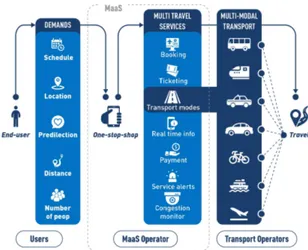
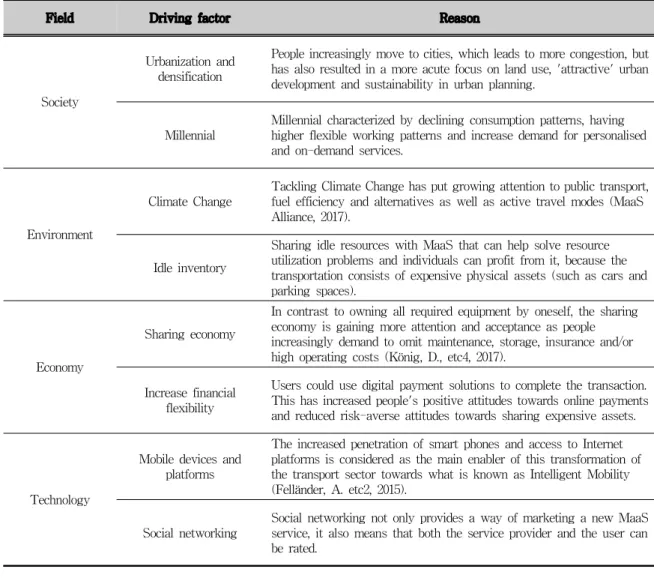
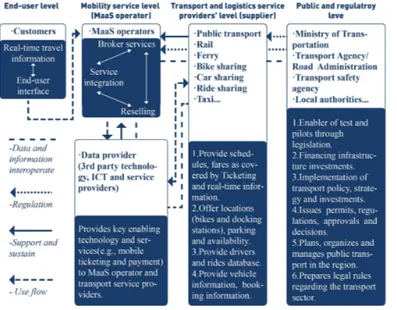
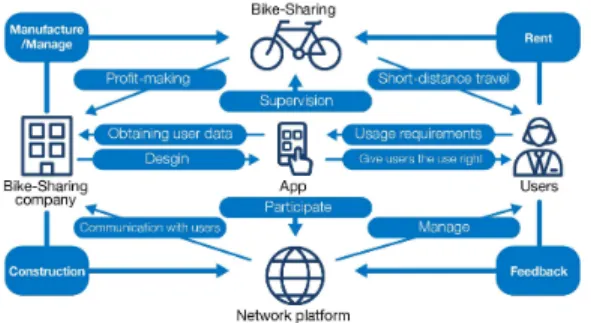
관련 문서
Research design, data, and methodology – The payment balance is a ratio of payment amounts made this country abroad and the receipts received by it from abroad for a
Based on experience in some OECD countries, Korea could reform its existing energy tax system more environmentally-friendly including the introduction of a carbon tax,
The objective of this research is to propose a method for evaluating service reliability based on service processes using fuzzy failure mode effects analysis (FMEA) and grey
The Effect of Shared Leadership on Voice and Knowledge Sharing Behavior: Creative Self-Efficacy and Change.. Self-Efficacy
In terms of the relationship between personal service contact and passengers' emotions, this study classified service contact quality factors into four groups based on
At last, the paper comparative study on South Korea and China consumer's overseas travel pattern and travel behavior and predict the South Korea's and
classifies data (constructs a model) based on the training set and the values (class labels) in a.. classifying attribute and uses it in
As shown in the results of this study through research methods and data processing described above, since customer service is increasingly important, dance
